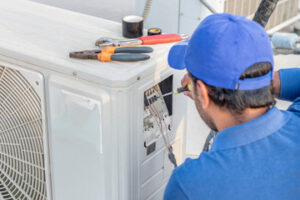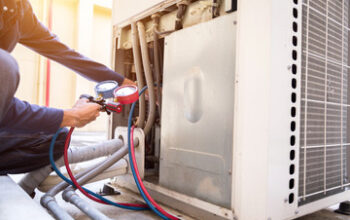Air conditioning installation is entering a smarter and quieter era. It’s no longer just about keeping rooms cool. Installations now consider long-term energy cycles. Every step is designed for comfort, savings, and sustainability.
New systems focus on minimal surface disruption. Drilling and pipe-routing are now planned using 3D scans. These scans detect wall structures in advance. This prevents unnecessary holes and keeps finishes intact. Contact AIR CONDITIONING INSTALLATION MILFORD OH for professional help.
Technicians are adopting airflow simulation before installation. Virtual models show how air will circulate in the room. Vents are placed based on real-time flow predictions. This maximizes cooling without overworking the unit.
Smart thermostats are now pre-linked during installation. The setup includes user profiles from the beginning. These profiles learn habits and adjust settings. Comfort is managed automatically over time.
Quiet mounting brackets are a recent addition. They absorb vibration from compressors and blowers. This keeps the walls from echoing noise. Bedrooms and offices remain peaceful after installation.
Invisible drainage systems are becoming more common. Instead of visible pipes, units now hide them within molding. Condensation drains without affecting room aesthetics. It’s form and function in one flow.
Remote diagnostics are now installed as standard. Units come with sensors that report issues early. Technicians can assess problems without home visits. This reduces downtime and repair costs.
The angle of the unit is now more critical. Sloped installation helps condensation flow evenly. If done wrong, water pools or leaks. Precision in mounting makes or breaks performance.
Outdoor units are placed with airflow shadowing in mind. This means using structures to reduce sun exposure. Shade extends compressor life and improves efficiency. It’s cooling protection for your cooling device.
New walls now come with pre-built cooling zones. These are cutouts designed for direct AC fit. It saves time and avoids wall demolition. Futureproofing structures is part of smarter design.
Installers now offer pre-cooling planning with architects. Cooling zones are mapped before walls go up. This removes guesswork and minimizes retrofits. Comfort begins at the blueprint stage.
Low-height installation options are trending in minimalist homes. Units are mounted closer to the floor. This helps even cooling for high-ceiling areas. It balances aesthetics and functionality.
Ceiling-embedded units are growing in popularity. They blend with lighting fixtures and fans. The design keeps the walls bare and stylish. You get climate control without bulky visibility.
Units are now installed with dust-resistance barriers. These are invisible mesh filters around air inlets. They reduce maintenance needs in dusty climates. Cleaner air flows without clogging filters quickly.
Technicians are offering silent zone configurations. These limit airflow in areas requiring peace. Bedrooms and libraries benefit from lower fan speeds. The system works without disturbing your calm.
Installations now include humidity-mapping before placement. This data decides where dehumidifiers are needed. Some systems split cooling and dehumidifying paths. Moisture control is no longer just an afterthought.
Energy-use transparency is being added during installation. A live panel shows usage after setup. This lets users understand daily consumption. Saving starts from day one.
Installers also ask about furniture layout now. Airflow can be blocked by bulky items. By knowing room design early, vents are adjusted. This avoids inefficient cooling zones.
Color-sensitive vents are another new touch. Covers can now blend with wall paint. They’re printed during setup using quick-dry ink. This keeps interiors visually seamless.
Systems are now installed with insect-proof mesh on intakes. This stops tiny pests from entering ducts. Especially useful in garden-facing homes. Cooling stays clean and uninterrupted.
Technicians now log air quality before turning on the unit. Baseline data is recorded for comparison. It proves the system’s improvement over time. You see the benefit beyond temperature alone.
Pre-installation airflow rehearsals are offered for sensitive spaces. This includes baby rooms and allergy zones. Temporary units simulate full operation. Adjustments are made before permanent mounting.
Some units now include scent modules added during install. These are optional but trending. They release mild natural aromas while cooling. Freshness goes beyond just temperature.
Eco-install kits are becoming a standard choice. These use recycled mounting materials. Even the tubing insulation is made from plant-based foam. Installations now align with green living goals.
More households are choosing sound-insulated piping. These reduce refrigerant flow noise. It makes early morning and late night usage quieter. Comfort isn’t compromised by background humming.
Installers now use thermal vision before installation. It spots heat retention spots on walls. The AC is placed opposite high-heat zones. This promotes faster and balanced room cooling.
Split-zone planning is now recommended in multi-room homes. Instead of one strong unit, smaller ones are used. Each room gets a custom level of cooling. This saves energy while improving comfort.
Installers also advise clients on future expansion. Systems now include ports for second units. This allows easier upgrades later. Planning ahead saves cost in the long term.
Technicians are being trained in structural harmony. That means installing without harming beams or wall flow. Every cut is measured and reversible. No damage lingers once the unit is in.
Mounting surfaces are pre-treated for weight dispersion. Especially on thin walls, added bracing is used. It prevents cracking from long-term weight. Units stay secure for years.
Installers are offering family-based usage settings. A single system remembers everyone’s temperature preferences. It switches modes based on time or voice command. Even kids can control the comfort zone.
Units are installed with self-cleaning schedules now. They cycle through heat pulses to eliminate mold. This happens automatically each week. The feature is configured during initial setup.
Installers now offer airflow photography after setup. Infrared cameras show how cold air moves. It proves coverage and reveals blind spots. Users know their space is well-managed.
Back-up power inputs are also part of modern setups. These work with solar or battery kits. Units stay on during outages. Cool air is guaranteed even in blackouts.
Outdoor units are now installed with animal barriers. Small creatures often nest near compressors. Wire mesh and ultrasonic emitters prevent this. Functionality stays stable throughout the year.
Interior wall vibration checks are made before mounting. Some walls amplify noise more than others. Those walls get rubber dampeners. Peace and quiet are preserved.
Custom piping paths are chosen for vertical homes. Gravity helps drain condensation without pumps. It’s efficient and reduces system strain. These paths are calculated per floor layout.
Installers now pre-calibrate thermostat zones. Rooms with more sunlight get a different base setting. This improves comfort and avoids overcooling. Energy savings follow from smart adjustments.
Units now have modular installation kits. This allows parts to be swapped easily in future. Repairs or upgrades don’t need full replacements. Longevity becomes a built-in feature.
Condensation outlets are now linked with plant irrigation. Instead of waste, the water feeds gardens. Tubing is routed directly to planters. Sustainability meets utility in a creative way.
Technicians are introducing install-time leak detection. A colored agent is used before full activation. It shows any cracks or faults immediately. This prevents issues down the line.
Touchless wall panels are now mounted beside doors. No need to tap buttons to change settings. A hand wave activates cooling mode. Hygiene meets high-tech control.
Installers also give air-speed tuning by room type. Lounges need a wider flow, while kitchens need direct blasts. The system is adjusted based on activity. One size no longer fits all.
Some installations offer daylight-syncing. The AC runs stronger as sun rays peak. It slows as the room dims. Cooling feels natural and aligned with your day.
Units now feature noise camo design. Fans operate at variable speeds that mimic nature sounds. It blends with home ambiance. Cooling feels less artificial.
Installers also offer education during setup. Clients learn how their system breathes. It helps them troubleshoot early signs. Empowered users take better care of their systems.
Post-install reviews are now conducted via app. Users record sounds or temperatures daily. The app sends insights and flags problems. It’s a new standard of ongoing care.
Smart vents are positioned for scent control too. They close during cooking or cleaning. This isolates smells and maintains freshness. Clean air stays where it should.
Each installation includes a climate forecast test. The system is evaluated under simulated weather shifts. It adjusts settings for rainy, dry, or humid days. Future weather is now part of setup.
Your cooling system isn’t just an appliance now. It’s a responsive and evolving part of your home. Installation shapes how you live and feel. It’s comfort designed from the first screw.

